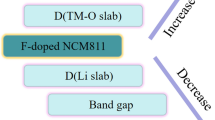Abstract
Based on density functional theory (DFT) of the first-principle for cathode materials of lithium ion battery, the electronic structures of (Li1−x Me x )FePO4 (Me=Na and Be, x=0–0.40) are calculated by plane wave pseudo-potential method using Cambridge serial total energy package (CASTEP) program. The calculated results show that Li-site doping can improve the electronic conductivity enormously. Doping with Na has a noticeable effect on improving its electrical conductivity. However, serious structural distortion will occur when its doping density is beyond 0.25. In view of this, the best density of doping Na is less than 0.25. Doping with Be has an inconspicuous effect on increasing its electrical conductivity and has good cyclical stability, but it cannot achieve as good results as when it is doped with Na. Therefore we cannot find a middle ground between the two proposals. Considering cost and environmental protection, it is ideal to choose Na. So this method gives a reasonable prediction to the improvement of electronic conductivity through Li-site doping in LiFePO4 material.
Similar content being viewed by others
References
Kang K, Meng Y S, Breger J, et al. Electrodes with high power and high capacity for rechargeable lithium batteries. Science, 2006, 311: 977–980
Taberna P L, Mitra S, Poizot P, et al. High rate capabilities Fe3O4-based Cu nano-architectured electrodes for lithium-ion battery applications. Nat Mater, 2006, 5: 567–570
Huang Z W, Hu S J, Hou X H, et al. Dead lithium phase investigation of Sn-Zn alloy as anode materials for lithium ion battery. Chinese Sci Bull, 2009, 54: 1003–1008
Sun Y H, Liu D Q, Yu J, et al. Synthesis and electrochemical proper ties of Ti-doped nonstoichiometric LiFePO4 for lithium-ion battery application. Chin J Inorg Chem, 2006, 22: 1711–1714
Park J S, Lee K T, Lee K S. Effect of Fe2P in LiFePO4/Fe2P composite on electrochemical properties synthesized by MA and control of heat condition. Rare Metals, 2006, 25: 179–183
Kang B, Ceder G. Battery materials for ultrafast charging and discharging. Nature, 2009, 458: 190–193
Hu G R, Gao X G, Peng Z D, et al. Synthetic LiFePO4/C without using inert gas. Chin Chem Lett, 2007, 18: 337–340
Tang Z Y, Ru Y L. Effects of different carbon source on the performance of LiFePO4/C composite cathode material. Acta Chim Sin, 2005, 63: 1500–1504
Luo S H, Tang Z L, Lu J B, et al. A novel synthetic route for LiFePO4/C cathode materials by addition of starch for lithium ion batteries. Chin Chem Lett, 2007, 18: 237–240
Hou X H, Hu S J, Li W S, et al. Ab initio study of the effects of Ag/Mn doped on the electronic structure of LiFePO4. Chinese Sci Bull, 2008, 53: 1763–1767
Ouyang C Y, Wang D Y, Shi S Q, et al. First principles study on NaxLi1−x FePO4 as cathode material for rechargeable lithium batteries. Chin Phys Lett, 2006, 23: 61–64
Shi S Q, Liu L J, Ouyang C Y, et al. Enhancement of electronic conductivity of LiFePO4 by Cr doping and its identification by first-principles calculations. Phys Rev B, 2003, 68: 195108–195112
Ceder G, Chiang Y M, Sadoway D R, et al. Identification of cathode materials for lithium batteries guided by first-principles calculations. Nature, 1998, 392: 694–696
Wolverton C, Zunger A. First-principles prediction of vacancy order-disorder and intercalation battery voltages in LixCoO2. Phys Rev Lett, 1998, 81: 606–609
Hou X H, Hu S J, Li W S, et al. The investigation of lithiation/delithiation mechanism in lithium-tin alloy for anode materials (in Chinese). Acta Phys Sin, 2008, 17: 3422–3427
Xu Y N, Chung S Y, Bloking J T, et al. Electronic structure and electrical conductivity of undoped LiFePO4. Electrochem Solid-State Lett, 2004 A, 7: 131–134
Tang P, Holzwarth N A W. Electronic structure of FePO4, LiFePO4, and related materials. Phys Rev B, 2003, 68: 165107–165113
Andersson A S, Kalska B, Haggstrom L. Lithium extraction/insertion in LiFePO4: An X-ray diffraction and mössbauer spectroscopy study. Solid State Ionics, 2000, 130: 41–52
Shi S Q, Ouyang C Y, Xiong Z H, et al. First-principles investigation of the structural, magnetic, and electronic properties of olivine LiFePO4. Phys Rev B, 2005, 71: 144404–144409
Vanderbilt D. Soft self-consistent pseudopotentials in a generalized eigenvalue formalism. Phys Rev B, 1990, 41: 7892–7895
Perdew J P, Chevary J A, Vosko S H, et al. Atoms, molecules, solids, and surfaces: Applications of the generalized gradient approximation for exchange and correlation. Phys Rev B, 1992, 46: 6671–6687
Huang K, Han R Q. Solid State Physics (in Chinese). Beijing: Higher Education Press, 1998
Author information
Authors and Affiliations
Corresponding author
About this article
Cite this article
Hou, X., Hu, S. First principles studies on the electronics structures of (Li1−x Me x )FePO4 (Me=Na and Be). Chin. Sci. Bull. 55, 3222–3227 (2010). https://doi.org/10.1007/s11434-010-3025-7
Received:
Accepted:
Published:
Issue Date:
DOI: https://doi.org/10.1007/s11434-010-3025-7




